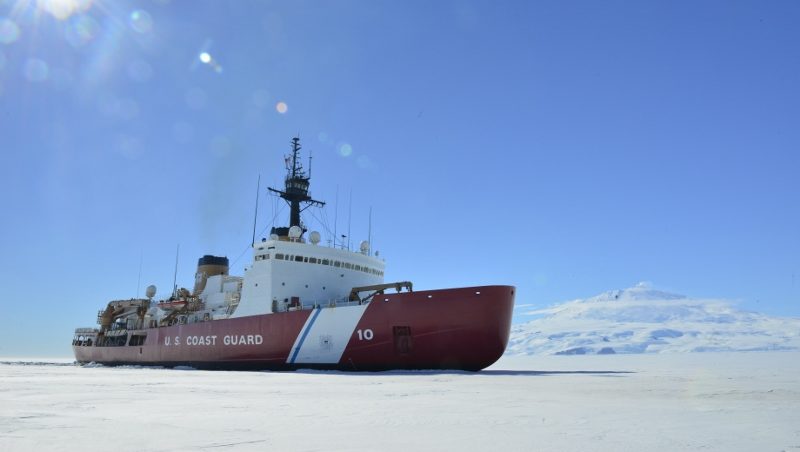The Coast Guard icebreaker Polar Star arrived Jan. 17 on its annual deployment to Antarctica, as its crew continues to battle the 42-year-old ship’s aging equipment.
The 399’x83’x31’ Polar Star came to the U.S. science mission logistics hub at McMurdo Station, breaking through 18 miles of ice to bring in a Military Sealift Command-chartered Crowley Technical Management resupply ship, the 545’x76.3’ Ocean Giant with 400 containers of supplies. The U.S. military provides join maritime and air support in Operation Deep Freeze for the National Science Foundation, which manages the nation’s Antarctic programs.
On their way south from their homeport in Seattle, the Polar Star’s 150-member crew contended with more of the increasingly difficult issues that plague the nation’s only operational heavy icebreaker, commissioned in 1976.

Divers repair a shaft seal on the Coast Guard icebreaker Polar Star off Antarctica in January 2019. Coast Guard photo.
On this voyage one of the ship’s electrical systems began to smoke, causing damage to wiring in an electrical switchboard, and one of the ship’s two seawater evaporators, used to make potable water, also failed.
Icebreaking operations had to be halted when a propeller shaft leak was detected, until divers could get under the ship to repair a shaft seal. The Polar Star carries a hyperbaric chamber, on loan from the Navy, so divers can make external emergency repairs and inspections of the ship’s hull when it is on its own in the far south.
More electrical problems flared up during icebreaking, and the crew had to spend nine hours shutting down the ship’s power plant and rebooting the electrical system to get the system back on line.
The Polar Star’s sister ship Polar Sea remains tied up in Seattle, and has been a source of spare parts. But technicians have also resorted to scrounging on the Internet to obtain hard-to-find components for the Polar Star’s old electrical system, Coast Guard officials have testified to Congress.
During its early 2018 mission to Antarctica, the Polar Star came close to major failures during its icebreaking operation to McMurdo, including a shaft seal that let water into the engine room at 20 gals. per minute, and a shutdown of one of its three 25,000-hp Pratt & Whitney gas turbines, which the crew traced back to a programming problem between the engine and the old electrical system.
If a major mechanical casualty were to happen when the ship is in ice, the Coast Guard would have few rescue options. Its only other icebreaker is the 420’x82’x29’ medium Healy, built to handle research missions in the Arctic.
“Protecting national interests in the polar regions is essential to ensure the Coast Guard’s national defense strategy and search and rescue capabilities are ready for action, but in order to do so, the icebreaker fleet requires modernization,” the Coast Guard pointedly noted in a statement about the McMurdo mission. “If a catastrophic event, such as getting stuck in the ice, were to happen to the Healy in the Arctic or to the Polar Star near Antarctica, the U.S. Coast Guard is left without a self-rescue capability.
“By contrast, Russia currently operates more than 40 icebreakers – several of which are nuclear powered.”
The Coast Guard and its allies in Congress are pressing for construction of a new icebreaker fleet, with at least six ships to be built through the 2020s. Advocates for that program have re-branded it as the “polar security cutter.”
“While we focus our efforts on creating a peaceful and collaborative environment in the Arctic, we’re also responding to the impacts of increased competition in this strategically important region,” said Adm. Karl Schultz, commandant of the U.S. Coast Guard. “Our continued presence will enable us to reinforce positive opportunities and mitigate negative consequences today and tomorrow.”





